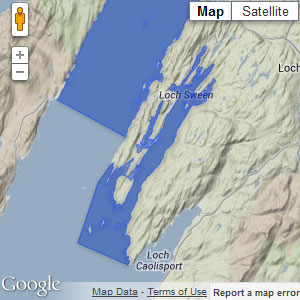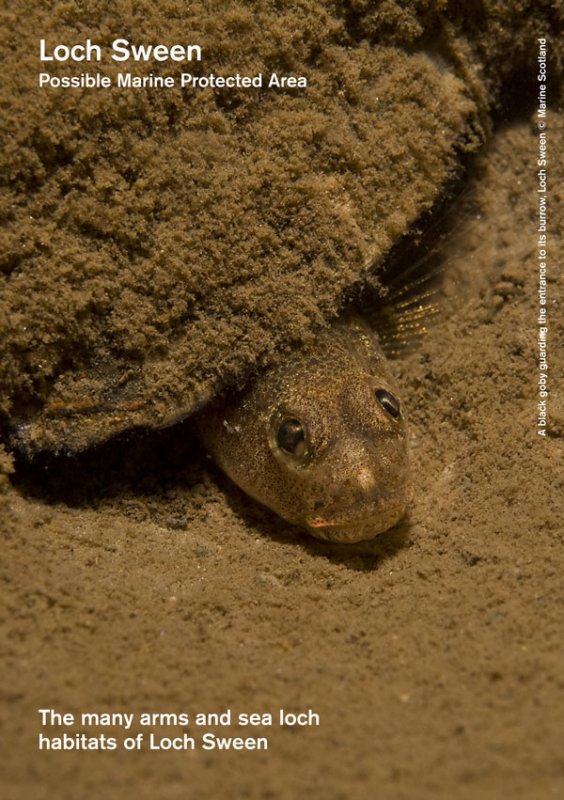 Loch Sween, a fjordic sea loch situated on the west coast of Scotland near Lochgilphead, has a complex shape with a number of arms branching off a central basin. Tidal movement through the main body of the loch and these narrow arms creates a range of different physical conditions in which a diversity of seabed habitats thrive. Deep, still waters throughout the loch are home to dark, quiet, mud habitats. Here, large, green volcano worms live in burrows beneath the sea bed. The only physical evidence of their presence are impressive dome-shaped mounds on the surface of the mud created when they excrete the sediment they have ingested. The volcano worms share their muddy domain with other animals including Norway lobsters, shrimps and burrowing gobies.
Loch Sween, a fjordic sea loch situated on the west coast of Scotland near Lochgilphead, has a complex shape with a number of arms branching off a central basin. Tidal movement through the main body of the loch and these narrow arms creates a range of different physical conditions in which a diversity of seabed habitats thrive. Deep, still waters throughout the loch are home to dark, quiet, mud habitats. Here, large, green volcano worms live in burrows beneath the sea bed. The only physical evidence of their presence are impressive dome-shaped mounds on the surface of the mud created when they excrete the sediment they have ingested. The volcano worms share their muddy domain with other animals including Norway lobsters, shrimps and burrowing gobies.
This site now has fisheries management measures in place.
Read our response to 2015 consultation for management measures on this site:
Save Scottish Seas campaign members have assessed the Scottish Government’s MPA proposal for this site as part of its consultation response.
We fully support sustainable methods of fishing such as hand gathering of shellfish, provided it is carried out at sustainable levels. However, in the specific case of Loch Sween we believe that the prohibition of hand gathering for the conservation of the native
oyster is appropriate as it eliminates any possibility of native oyster being accidentally or
deliberately removed when fishing for other shellfish species.
We support the prohibition of mobile demersal fishing gear use in the body of Loch Sween in the
designated area for the conservation of maërl beds, burrowed mud, and sublittoral mud and mixed
sediment communities. These key habitats support an abundance of biodiversity, including
populations of commercially important species, and habitats such as maërl beds also provide a
refuge for juvenile fish and shellfish.However, we do not agree that this approach will provide sufficient management to achieve the
conservation objectives for this site and we suggest that a more comprehensive ecosystem approach
will be required.We contend that Approach 1 does not provide sufficient management to achieve the conservation objectives and should not be considered as the approach to take forward for Loch Sween. This approach provides minimal protection and only addresses the conservation of small areas for certain features, which leaves limited scope to maintain the biodiversity of the wider ecosystem and other key features such as burrowed mud.
We agree with the management advice to remove/avoid pressure from native oyster, maërl beds,
burrrowed mud and sublittoral mud and mixed sediment communities and in principle we support
the management measures proposed in Approach 2. However we suggest that a more appropriate
option, which is more likely to achieve the conservation objectives for this site, would be to extend
the prohibition on the use of mobile demersal gear throughout the entire site. The burrowed mud
communities in Loch Sween represent a particular community that isn’t the same as in other areas
around Scotland – noting that the management advice for the burrowed mud and sublittoral mud
and mixed sediment communities in this site is specifically remove/avoid pressure – which strongly
supports the rationale for a site-wide prohibition on trawling on these habitats. Following verbal
information from SNH at the stakeholder workshops in October 2014 that recent surveys of the loch
found that maërl beds have been reduced to mere fragments, there is clearly an unacceptable level
of sea bed damage occurring in this MPA. We do not agree that a 75GRT vessel capacity restriction
will achieve anything for the conservation of the burrowed mud and its communities, as nearly all of
the vessels fishing within the loch will be far smaller than this. Furthermore, even a reduced level of
trawling can still damage or remove delicate species that inhabit the burrowed mud. Research
indicates that trawling on burrowed mud has a negative cumulative impact on the abundance and
richness of the communities that inhabit it, therefore a lower vessel capacity is only likely to slow
any biodiversity decline within the mud habitat, rather than halt it.
Read our response to the 2013 site consultation here:
Save Scottish Seas campaign members have assessed the Scottish Government’s MPA proposal for this site as part of its consultation response.
LINK supports the designation of the Loch Sween possible Nature Conservation MPA for the protection of burrowed mud, maerl beds, native oysters and sublittoral mud and mixed sediment communities. The boundary is fully supported though the information pertaining to the seaward part (Keillmore, Loch na Cille, Macormaig Isles) is not well presented. This is a region of complex underwater topography and very high tidal streams, in marked contrast to the rest of the site. It is likely that maerl beds are more extensive than shown here.
Without a more detailed assessment of fishing levels, we are unable to support the conservation objectives. We would support removal of fishing pressure from maerl beds and native oysters and reduction of pressure on mud habitats. If fishing activity has not previously been excluded from areas of maerl and oyster, a precautionary approach would suggest that they have been impacted and therefore the conservation objective for these features should be set to ‘recover’.
Management Options:
The management options discussed but need a more realistic assessment of fishing levels. We are also concerned about the impact of recreational anchorages on maerl in outer Scotnish narrows and ask that this recreational anchorage be reviewed to ensure it is not in the vicinity of any maerl habitat. If it is in the vicinity we would request that it be moved in order to mininise impact on maerl.Socioeconomic Assessment:
LINK acknowledges the important contribution of the Marine Conservation Society in bringing this possible MPA to the consultation stage.
This contribution is an excellent demonstration of the high value that communities, both of place and of interest, put on the integrity of the marine environment. It also points to the existence of the non-use value of MPAs that has been largely omitted from the economic assessments.
The MPA documents are deficient in their assessment of current levels of fishing. For instance the creeling pressure is assumed to be for crabs whereas most is currently for Nephrops and therefore affects a different habitat type. Mobile gear is only likely to affect sites over 10 m depth and Linnhe Mhuirich is inaccessible except to boats of shoal draft. Scallop dredging has been intense in the region of Keillmore – Macormaig Isles in 2013.
The potential value of the Loch Sween possible MPA to divers and sea anglers has been estimated at £7.6 to £15.9 million based on willingness-to-pay measures (Kenter et al., 2013) . Kenter et al. also found important emotional and well-being benefits associated with the Loch Sween possible MPA, with divers and anglers responding to questionnaire scoring >4 (out of a maximum score of 5) for engagement, therapeutic, spiritual, transformative and social wellbeing indicator valuesIn the absence of detailed information relating to the impacts of aquaculture on proposed protected features within an MPA it is imperative that the precautionary approach be applied. Discussions with finfish farming interests cannot be used as a proxy for specific, detailed information and where doubt exists management measures must be precautionary.
Loch Sween is a remarkable sea loch both in terms of its physiography and its biota. Its listing as an MPA s fully supported. Clarification of fishing pressures is urgently needed. The habitats/species present in the complex topography around the Macormaig Isles are not well described.
Note that Loch Sween is also a marine algae Important Plant Area (IPA) as the site has diverse and unusual algal assemblages. Rare or threatened species: Phymatolithon calcareum.
Check out the official documents relating to the Loch Sween MPA on the Scottish Natural Heritage website.
[1] Loch Sween MPA site summary, SNH

